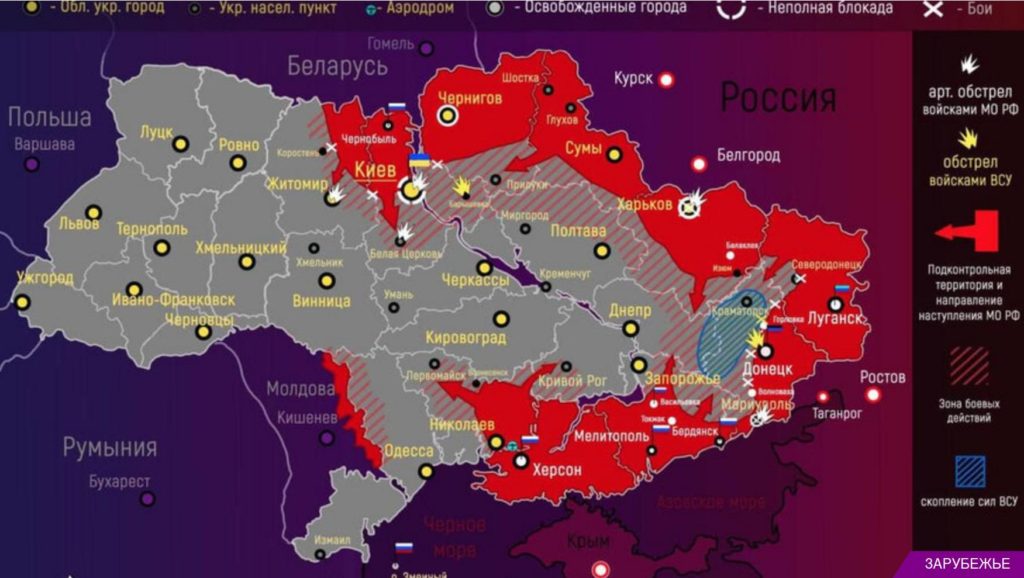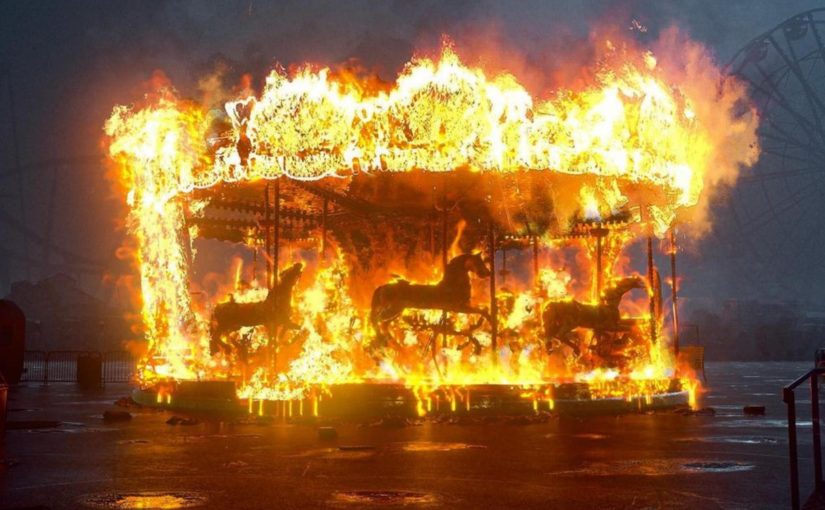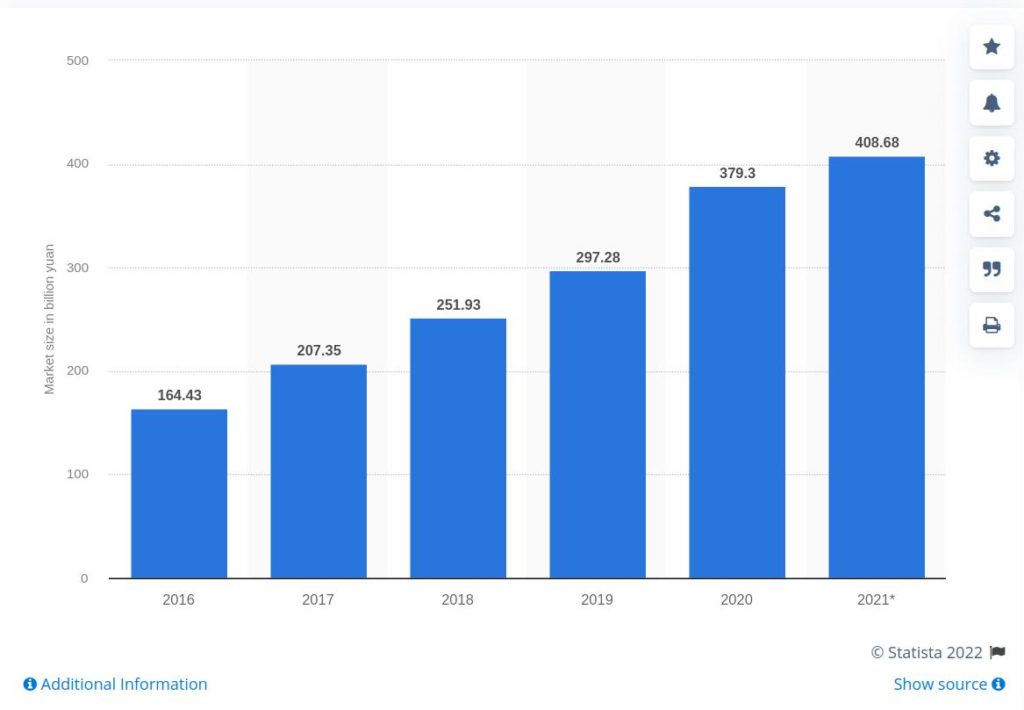Ugh. It’s been an exciting last couple of days, eh?
As of the 1MAR22, the military movement map is on schedule. Anyone who says that it is going slowly is overly influenced by Western propiganda. It’s going to schedule and meeting all of its objectives. There are no problems here.

I am seeing pincer movements, and the creation of pockets and cauldrons (black lines.). You can observe them on the map above.
Like many of you, I have been spending a great deal of time keeping up with coverage of Russia’s invasion of Ukraine. There’s so much bullshit out there, and much of it is in the English speaking press. It’s really awful.
I covered that elsewhere.
If you have been taking-in the Western propaganda, you might have all sorts of distorted views and illusions about what is going on. Such as this…
"I am very upset with the Russians for choosing to invade the whole country, because now a line has been crossed that will never, ever be able to be uncrossed. From here on out, there will be endless wars and rumors of wars, and countless numbers of people are going to die. In the future, some historians may look back and determine that the coming Chinese invasion of Taiwan was the start of World War III, and others may point to the coming conflict between Israel and Iran. But to me, February 23rd, 2022 was the start of World War III, and nothing will ever be the same again."
Well, it’s not like that at all.
It was NATO and the United States that crossed the Russian “Red Lines”. This was the reaction that they were warned about. It’s reffered to as the “non-ultimation; ultimation by Putin“.
Google it, if you are unaware of it’s existence.
It demanded that both NATO and the United States abide to the treaties that they signed. In particular three treaties were specified. All three were in blatent violation.
The ultimation was totally ignored by the American press, and the American leadership.
Since most of you have been closely following news coverage of the war, I am not going to rehash the basic facts here. The Russians are winning victory after victory, and it appears that the battle for Ukraine could be over in a matter of weeks.
The following are some observations about the new World War (cold or hot, it doesn’t matter) which just started in Ukraine…
#1 The United States launched it’s long awaited World War III.
Everyone knew that this was coming in one form or the other. Whether it is via the Fourth Turning, or the Deagal Report, or any Prepper websites, it happened to schedule and on time. No surprises there. And it was birthed directly by United States and NATO action. Make no mistake there, either. For a roll of the die, it could have been China. In any event, it pushed Russia into a corner using the "Cuba Missile Crisis" technique, and Russia had to respond. The United States is following the road map written decades ago and will not accept peer competitors from Asia.
#2 The propaganda is that it’s all Russia’s fault.
Of course. That's the standard American "play book". You omit any semblance of the truth, and then propagate the lie-based narrative. All the shrills and 'bots are fully mobilized. And it is outrageous.
#3 The conflict between the West and Asia will continue until one side or the other is totally defeated.
This is an all-or-nothing, winner-take-all, situation. Certainly, the neocons in Washington, DC anticipate a long-drawn-out war of attrition; a quagmire in Ukraine, and a leashing of the EU, my personal opinion says otherwise. Once Russia suppressed the Ukraine threat, the USA will push for another military action. They will not allow things to subside.
#4 Nuclear Detonations are likely.
Both sides are armed with nuclear weapons, and it is just a matter of time before somebody decides to use them. However, the Asian leadership has gamed everything here. Nothing is unexpected. Remember, both America and Europe are undefended. While both China and Russia ahve ABM technology that can shoot down any ICBM, SLBM, and cruise missiles sent to them.
#5 The stakes are well understood and public.
As he launched the invasion of Ukraine, Vladimir Putin warned other countries that he could use nuclear weapons against them if they attempted to intervene. Which is why you are not seeing any direct military movement from NATO or nearby nations right now. The action is covert, and hybrid. But not kenetic.
#5 Everyone is lying.
The Biden administration, the Ukrainians and the Russians all lied to everyone over and over again. The matter is simple; no one is respected, no one deserves the truth, and thus the true reality is to find the nation with the highest likelihood of truthful information. Since the United States is constantly at war, and constantly provoking wars, it is very easy to see what it actually is. This is true even though the American public has been dumbed down to the point of brainless zombie NPC. Russia, on the other hand, is clearly in a worrisome situation. America almost got into nuclear war over a similiar situation in 1962. And the Ukraine, is, like all the West, a puppet government doing the work desired by others. Like Australia. Like Japan. Like Canada. Mindless puppets.
#6 There are no diplomatic solutions.
The posturing by the United States, and the EU / NATO against Russia and China has been aggressive, "in-your-face", rude, arrogant, and bombastic. Anyone who berates Asia for not being diplomatic is an uninformed idiot. All you need to do is replay the Anchorage Alaska meeting in early April 2021 between the USA and China. Russia clearly laid down the "Red Lines". The United States and NATO decided to ignore them. What is happening is the consequece of that decision.
#7 The EU, NATO, and the United States are all conducting acts of war.
Personal sanctions against heads of state and individuals who work in government are de facto acts of war. Expect retaliation at some time. And remember, again, boys and girls, time is on the side of Asia. The West is on a clock that speeds up faster as energy, food, and commodities become scarse.
#8 The United States / EU are especially weak.
The West have no real defenses to handle an aggressive, peer-capable war. This is on all fronts, in every way. Whether it is cyber, bioweapon, social "color revolution", trade, financial, or military / technical. It takes fighters; people with merit driven skills to operate and engage in real war. World War III will not be fought inside bunkers with office workers pressing buttons. It will be fought by, and won by, organized and motivated fighters who are led by experienced merit promoted generals.
#9 Russia and China can both inflict terrible pain.
Russia and China are unified. Make no mistake about that. The Russians have more than 1,000 different ways of making the West feel pain, and they are not afraid to play dirty.
#10 Ukraine is a puppet vassal state.
I think that Volodymyr Zelensky is a piss-poor head of state. However, he's not the exception, he's the rule. He's a clone, with Scott Morrison, Joe Biden, and any of the EU clowns equally ill-infomed and technically powerless.
#11 Game over for the Ukraine.
Zelensky pushed all of his chips into the middle of the table when the Russians knew full well that he wasn’t holding any cards. Now he is going to lose his entire country.
#12 The United States is a coward, bully.
It appears that Zelensky actually believed that the United States and other western powers would come to his aid if the Russians invaded. After what we have witnessed over the past year, that was an incredibly foolish thing to believe. The United States cases jack-shit about the rest of the world. It only cares about it's elite. No one else.
#13 The Western push followed plan “B”.
The war against China failed. The blocking of the BRI failed. So Plan "B" was put into play; Force Russia into a war. The so-called "diplomatic solution" was [1] the placement of nuclear weapons in Ukraine, and [2] it becomes a member of NATO. With [3] Russia backing down peacefully. [4] No one makes a big deal about the "Russian Red Lines", they are ignored and they disappear. That was the "diplomatic solution" that all the West are lamenting about. Diplomatic solution = Nuclear weapons in a NATO Ukraine. War solution = Russia ejects the minion government of Ukraine. From the point of view of the collective West; it was a win-win. No matter what Russia did, the plan would run it's course.
#14 The isolation of Russia will fail.
At this stage, the Biden administration will try to turn the rest of the world against the Russians and will try to suffocate the life out of them economically. That isn’t going to work, because Russia is very self-sufficient when it comes to food, energy and other essentials, and Putin has also signed very extensive trade agreements with China.
#15 All of this is well-panned and well thought out.
Putin would have made this move if he didn’t have an understanding with China behind the scenes. The Chinese are allowing the Russians to invade Ukraine. This is all part of a grander plan. The crazy United States monster is going to try to eat up Asia, one way or the other. If not Russia, it will be China. The nations have banded together for mutual protection.
#16 Taiwan
Now that the Chinese have seen how weakly the western powers have responded to the invasion of Ukraine, we can see how they might think about the reunification issue with Taiwan. It does NOT mean that it emboldens the Chinese to take action. They are following their own, well-thought-out timetable. And for them, Ukraine means nothing. It changes nothing. No. Instead, it alerts the separatist political factions inside Taiwan of the hopelessness of their objectives. As well as the pitiful support that they would actually get from the United States. Now they know what will happen with an alliance with the United States.
To this end, an urgent flight with American government officials are flying (have flown) to Taiwan to assure them that “America will support them against mainland China. Now, you must realize that this is a provocation, and it is very dangerous for the United States to do this. Know your history. video 6MB
#17 Ukraine
It will be restructured, and rules will be put in place so that [1] color revolutions can never reoccur ever again, [2] NGOs / CIA are kept out, [3] and it will be a neutral and demilitarized nation.
#18 Food and minerals
The Western "leadership" have no clear idea how actual physical things work. Those cell-phones are made in China, and have batteries made from minerals mined in Russia. The USA placed sanctions on everything except what they need. But you know that Russia could easily say "fuck you" to them at the right moment, and not ship anything to them. The global food crisis has just continued to get worse as global food supplies have continued to get tighter and tighter. Normally, Russia and Ukraine export vast quantities of food to the rest of the world, but the war is going to change that. We really are facing a horrifying breakdown of our food and energy systems, and that is going to affect every man, woman and child in the collective West. This war is going to make the global food crisis much worse.
#19 Energy
The global energy crisis is going to get a whole lot worse. Russia exports a tremendous amount of energy, and European nations gobble it up like addicts. This conflict threatens to dislocate the flow of global energy to a degree that we haven’t seen since World War II. Already, the collective West are already facing the worst energy crisis since the 1970s before the war broke out, and Russia is one of the most important energy producers on the entire globe. As energy markets are thrown into further turmoil, energy prices will go to unprecedented heights. This war is going to make the global energy crisis much worse. It will start with abnormally high energy prices, and then spiral into uncontrolable inflation. Then, it will get really bad...
#20 China & Russia financial transfers
SWIFT is going the way of the Doo-Doo Bird. And with the death of SWIFT will be a new reality where if you want things from China, you will have to pay using their system, and it requires to be backed up with gold reserves. The trouble is, the USA doesn't have any gold any longer.
#21 US Military is in sad shape.
The U.S. military is in the worst condition that I have ever seen in my entire lifetime. At this point, the U.S. military is not at all prepared to fight the Russians or anyone else for that matter.
#22 Russians are Ruthless.
Many people out there love to criticize President Trump, but even he understood that you don’t mess with the Russians. Unless they are messing with you, the best thing to do with the Russians is to just leave them alone. All throughout history, those that have chosen to pick a fight with Russia have ended up regretting it. The Russians will do whatever it takes to win, and they are absolutely ruthless.
#23 Ukraine President Volodymyr Zelensky is a no-show
It appears that Ukraine President Volodymyr Zelensky is either extremely courageous or he is flat out lying to us. If he is still in Ukraine, and that is a big if, then I have to applaud his courage and bravery. So many others would have fled in the face of a Russian invasion, but if he has chosen to stay and fight then his people are right to regard him as a hero. But if he has already left Ukraine and is just acting as if he has stayed behind to fight, then that is the opposite of courage. It is odd that the Russians haven’t been able to find Zelensky yet, because they have definitely been hunting for him. *Update* Zelensky fled to Poland. He abandoned his country and refused to negotiate with the Russians. Instead, he is staying in the United States Embassy. U.S. Embassy Warsaw Aleje Ujazdowskie 29/31 00-540 Warsaw Poland
#24 Begging for American Involvment
Zelensky is trying really hard to drag western powers into the war. He is begging Joe Biden to establish a “no-fly zone” over Ukraine, but Biden understands that this would mean direct military conflict with the Russians.
#25 Polish and EU fighter jets
The EU has announced that they will be providing fighter jets to Ukraine. This is an extremely dangerous thing to do, because Putin has warned that those that provide military equipment to Ukraine will be targeted as enemies. This is a lie. Yesterday's blazing headlines about European countries deciding to "give" fighter jets to Ukraine, to be based at an airfield in Poland, has completely fallen apart. As of this morning, NO country will be giving ANY fighter jets to the Ukraine. It's official - Europe won't transfer fighter planes to Ukraine. Poland decided not to, and Slovakian defense ministry spokesperson confirms just now: “Slovakia will not provide fighter jets to Ukraine." Yesterday, shortly after the spectacular claim by Ukraine, one of the countries, Bulgaria, flatly denied it saying they don't have enough planes to defend their own country, never mind giving some to another country. So once again, a spectacular claim by "officials" turns out to be an outright lie.
#26 NATO injection into the Ukraine
I don’t know why the EU believes that fighter jets will make much of a difference, because most of the military airfields under Ukraine’s control have already been destroyed. They would have to be based inside NATO and then fly into the Ukraine. In effect; an unofficial NATO incursion into war.
#27 Nuclear safties are OFF
The entire world was shocked when Putin put his strategic nuclear forces on alert over the weekend. Putin definitely escalated things dramatically by making this move, but hopefully it will get people to understand that we really could end up with a nuclear war at the end of all this. I was scratching my head with the moronic idiocy of the Western "leadership". The words "Duh!", and "Ya think!" come to mind.
#28 CIPS
Now that western powers have weaponized SWIFT, I think that there will be a mass exodus to China’s version. Most people have not even heard of CIPS (Cross-Border Interbank Payment System) until now, but this crisis is going to make it a lot more prominent. Not just Russia, either. But most of the globe.
#29 Stalling at the “Peace Talks”
I would love it if the “peace talks” between Russia and Ukraine brought an end to the shooting. Unfortunately, to me it appears that Ukraine is simply using those talks as a stalling tactic. Zelensky still seems to think that western powers can be dragged into the conflict, and so he is trying to buy as much time as possible.
#30 If not NATO then, the EU.
When Zelensky signed an application for Ukraine to become a member of the European Union on Monday, that was another clear sign that he has no intention of turning Ukraine into a “neutral country” like the Russians are demanding.
#31 The Ukraine as it exists now is over
Dead man walking. If Zelensky cannot get anyone to come help Ukraine, he will lose this war.
#32 A United Asia
Russia is not isolated. China is not isolated. Together they represent the bulk of argultural products, mineral resources, technology, and manufacturing. Throw in a pro-Russia and Pro-China Africa, and you see a very mighty powerful block. Meanwhiile, the West can play with their spreadsheets, their fianancial advisors, diversity experts and serve fast food to each other. The future of the world depends on Asia.
#33 Western Priorities
I think that Richard Moore, the chief of MI6, certainly revealed a lot when he tweeted this… “With the tragedy and destruction unfolding so distressingly in Ukraine, we should remember the values and hard won freedoms that distinguish us from Putin, none more than LGBT+ rights. So let’s resume our series of tweets to mark #LGBTHM2022.”
#34 Russia and China are as one
A major narrative being promoted out of the propaganda mills is that "Russia tricked China", and that "China is now worried". Both ideas are totally false bullshit. The Chinese media does not reflect those opinions, and the people on "the street" do not feel that way at all. Inside China the over all feeling is that Russia is defending itself against the USA / NATO alliance, and that it needs to do so.
#35 Russia eliminated all the pricy expensive weapons systems in one day
The Russian attack began, as predicted, mostly by strikes with standoff weapons. 24 hour hours later the Ukrainian air force and navy ceased to exist. In this initial phase, few Ukrainian units were directly engaged. All of those very expensive fighter aircraft, electonic systems, high-technology weapons provided to the Ukraine by the United States (it has been the fourth largest recipient of American weapons) became useless slag in 24 hours.
#36 The United States won the propaganda war
On the informational war, the West gave Russia a thorough thrashing: RT and Sputnik are banned everywhere, absolutely insane rumors are circulating (see example below), I know for fact that some US colleges have banned their computers from accessing any .ru or .su websites – yes entire domain names are being shut down – Russian diplomats get assaulted (in one of the 3Bs statelets if I remember correctly). The western PSYOP onslaught is so powerful that even some people in Russia are fearful and sincerely worry “what will happen to us next?!”. Western IT companies are disconnecting, throttling, while “private” western crackers are unleashing DDoS attack on pretty much all the main Russian websites, not only informational ones, but also those who are used to run the civilian infrastructure of Russia. I am not impressed by how much (or little) Russian PR people did to prepare for this which was easy to see coming. Here, again, the West so far is winning, but a huge margin. The western society is displaying its hatred of all things Russian in every way it can: hundereds and maybe thousands of students are summarily expelled from western colleges (which used to be bastions of freedom). In a Swiss city a child was beat up in school for being an “evil Russian”. Artists are expelled, others pressured to condemn their own country and president, western presstitutes and politicians unceasingly vomit at Russia, Russians and everything Russian!
I have two videos that cover this particular subject that I want to present. The first is a pretty good, and short overview of just how absurd the fake news actually is. Its from RT and its banned in the West. Imagine that! Keep Americans and Europeans ignorant. video 27MB
The second video is about how the “news” reports are presented to the American public. It’s funny, but keep in mind, this is actually what happened. Its no wonder that Americans (and Brits) have no idea about how FUCKED they actually are. video 6MB
#37 Much of the situation is hidden
All of the "armchair generals", "talking heads", and "political analyists" are working with public dialog to base their impressions upon. The US government controls that dialog. Thus, as a matter of course (like an iceberg) 90% of the real issues are hidden. There's things going on that are not being reported. So all these "experts" are living in an echo-chamber of ignorance.
#38 Life in the West is forever changed
If you live in the West, and you believe that your life will continue on as normal because the war between Russia and Ukraine is on the other side of the globe, you should think again. The United States and the EU are consumer-driven societies. What happens when all products are cut off, inflation goes ballistic, and raw materials foodstuffs, and energy are denied to you? Thos electric cars all use batteries. In two years they will need to be replaced. And Russia and China controls the materials and the manufacture of those batteries. 60% of Americans are on life-sustaining medicines. And 90% of the medicines are made in China. What then? No prosac, viagra, blood-pressure, cancer, or pain medicine... America will become a zoo.
#39 Inside of America there is a growing division of opinion
There are cracks in the Ukraine narrative. The American Conservative websites and media are starting to question why Biden went after Russia when they view China as the threat. To this end they are posting videos and narratives in suppor that the United States intentionally decided to engage Russia in war. The most stunning was from Hall Turner who posted a video regarding the true situation.

#40 The Deagel Report is still profoundly accurate
All of the events as they transpire confirm the accuracy of the remote viewing of 2025.
#41 The Generational Theory and the Fourth Turning is all on schedule
Everything as predicted is falling in place along the generational time-table. Nothing strage indicated a deviation or that this period of time will be an exception. It's all happening now.
#42 The recent American deligations to Taiwan suggest the USA is opening a second front
Anticipate a crossing of China's "Red Lines", and a harsh reaction. I suspect sometime soon. Probably this year. China tends to perform tit-for-tat actions. You destroy their VTOL carrier, and they destory yours. Etc. But somehow, I think that China might need to just cleans the Pacific of US Naval forces and their bases completely.
#43 Germany’s economy is set for wide-scale collapse
Russia has targeted the German automotive industry. This is the largest employer in Germany. Already two ships (HERE and HERE) loaded with German automobiles have sunk in the last week. And the Industry itself is laying off workers due to the inability to acquire parts.
#44 Bioweapons
15 bioweapons facilities set up by the United States and run by the United States were in place on the Russian border. During the initial salvo, every single one was hit with large thermobaric weapons. Most of them were absolutely and completely incenerated. None of this is reported anywhere in the West. In spook language; this means that something was up BIG TIME.
#45 In spook circles it is believed that Putin prevented a NATO attack
Speaking of spook stuff…
Not published. Just unattributed raw intel. But apparently Putin "jumped the gun" and prevented a nuclear attack that was to launch in the Summer of 2022. Only one week (actually some reports say days) NATO and USA nuclear weapons would have been in position in the Ukraine by 9MAR22. If so, then it would have been too late for Putin to stop the West. Doing so woould mean direct confrontation with NATO and American miltiary forces inside of the Ukraine.
#46 Many in the West assume that the entire world is collapsing
It is not. That's just an illusion. Many Americans are angry, and the over all opinion is that the entire world is going to Hell. That is not correct. Only the West is falling towards Hell. Not the East. Of course, no one knows this because the news media never reports on what the rest of the world is like.
So yeah. Energy shortages, food shortages, high inflation, and decay are going to erupt all over the United States and their proxy nations. But not inside of Russia, the breadbasket of the world, and not inside of China, the manufacturer for the world.
Of course, those in Russia and China will continue to eat well.
Let’s start by taking a look at the impact that this war will have on food supplies. Even the Washington Post is admitting that the war in Ukraine will likely “push U.S. food prices even higher”…
Russia’s invasion of Ukraine could push U.S. food prices even higher, as the region is one of the world’s largest producers of wheat and some vegetable oils. And the disruptions could drag on for months or even years, as crop production in the area could be halted and take a long time to restart. This new inflation shock comes at a time when global markets remain extremely strained because of pandemic-related disruptions. The price changes impacted commodity prices in recent days and could flow through to higher costs at grocery stores and restaurants soon.
Food prices have already been rising very aggressively all over the world, and this has pushed millions upon millions of poor people at the bottom of the economic food chain into hunger.
But now this war threatens to push this crisis to a dangerous new level, because Russia and Ukraine typically produce “nearly a quarter of the world’s wheat”…
Russia and Ukraine together produce nearly a quarter of the world’s wheat, feeding billions of people in the form of bread, pasta and packaged foods. The countries are also key suppliers of barley, sunflower seed oil and corn, among other products.
So if exports from those two warring nations are reduced or completely cut off, how is the West possibly going to replace that output?
Does anyone have an answer for that?
Collectively, Russia and Ukraine usually account for “29 percent of all wheat exports and 75 percent of global exports of sunflower oil”…
Ukraine is the world’s fourth-largest exporter of both corn and wheat. It is also the world’s largest exporter of sunflower seed oil, an important component of the world’s vegetable oil supply. Together, Russia and Ukraine supply 29 percent of all wheat exports and 75 percent of global exports of sunflower oil, said Kelly Goughary, senior research analyst Gro-Intelligence, an agriculture data platform.
This isn’t just bad.
This is really bad.
The global agricultural production is going to be down all over the globe in 2022 because fertilizer prices have started to spiral out of control. In fact, in Africa alone it is being projected that enough food to feed 100 million people will not be grown this year because of the outrageous cost of fertilizer.
Well, guess what?
It turns out that Russia is one of the biggest global exporters of fertilizer…
Russia is a key global player in natural gas, a major input to fertilizer production. Higher gas prices, and supply cuts, will further drive fertilizer prices higher. Russia is one of the biggest exporters of the three major groups of fertilizers (nitrogen, phosphorus and potassium). Physical supply cuts could further inflate fertilizer prices.
One expert that was interviewed by the Washington Post admitted that we are “headed for a supply crunch that will be hard to resolve”.
That is one of the biggest understatements that I have heard in a long time.
Even before the war erupted, some types of fertilizer had doubled in price, some had tripled in price and some had actually quadrupled in price.
In the trade channels there’s some alarmist talk about American grown food. One industry insider told me about fertilizer prices. He warned that many farmers all over the U.S. simply will not be able to grow corn this year because it will not be profitable due to soaring fertilizer prices.
And now fertilizer prices are likely to go much higher.
This really is a nightmare.
Six months down the road, we are likely to see food riots all over the West.
Meanwhile, the global energy crisis is entering a very alarming new chapter.
According to USA Today, 30 percent of all natural gas that Europe uses is provided by Russia…
Russia accounts for more than 30% of Europe’s gas for home heating, industry and generating electricity, and other potential supply sources are not adequately prepared to bridge the gap if Russian gas is curtailed, Rystad Energy analysts say.
Europe is absolutely addicted to Russian gas, and without it normal life in many European cities would rapidly come to a grinding halt.
There are some that are suggesting that imports of liquefied natural gas from the United States could help while the war is raging…
Supplies of liquefied natural gas brought by ship from the U.S. has helped relieve some of Europe’s gas shortage this winter, but it’s expensive. Meanwhile, natural gas prices in the U.S. are approximately 60% higher than a year ago, according to Rystad.
Sadly, natural gas prices all over the globe are going to continue to go higher.
As will propane prices.
As will coal prices.
And the price of oil will soon leave the $100 per barrel threshold in the rear view mirror for good.
Joe Biden is publicly saying that he will do all that he can to keep the price of gasoline down, but meanwhile his administration is working extremely hard “to freeze new oil and gas drilling leases”… by kingly decree.
As oil prices continue to rocket, now further helped along by Russia’s invasion of Ukraine, the Biden administration is still fighting tooth and nail to freeze new oil and gas drilling leases – even after a court ruled against the administration for using a metric to estimate “the societal cost of carbon emissions” to justify their move. Despite the court’s ruling, Biden’s administration has stopped new leases and permits for federal oil and gas drilling, MSN reported this week.
So when you are soon paying seventeen dollars for a gallon of gasoline, just remember who did this to you.
The United States “leadership”.
Conclusion
Everything is changing, and the months ahead are going to be extremely challenging.
I think that Mike Adams summed up the current state of affairs very well when he warned that the United States and the collective West are heading for a “total collapse”…
In all, these factors combine (food, war, fuel, inflation, currency, etc.) to create a total collapse of the world we once knew. Forget about affordable food or just-in-time delivery of anything. The world is about to become extremely inconvenient, expensive and broken. The supply chain disruptions will get FAR worse from here forward, and crime is going to absolutely skyrocket out of sheer desperation. Expect to see flash mobs looting grocery stores in broad daylight. Carjackings will skyrocket. Home invasions will become commonplace, even outside the cities as looting gangs hit suburbs.
So many of the things that myself and others have been warning about for so many years are starting to come to pass right in front of our eyes.
The collective West is really heading into a nightmarish breakdown of society, and everyone (state side and in Europe) will be shaken to the core as it happens.
This is truly a sad day, because this didn’t have to happen. But, it did, just like the remote viewers of 2025 predicted, and like the Fourth Turning predicted. The United States is on a bobsled heading straight into the firey gates of Hell.
There is nothing more than can be done, because World War III has already started. And it’s really going to hurt the United States and Europe really hard. Things are set up to start getting really bad. I anticipate checking the boxes on lists that Xi Peng and Putin created.
From this point forward, global events are going to escalate rapidly. I would encourage all of you to prepare accordingly.
…
The end of the world did not occur yet, and the sky is not yet falling. What you can do is enjoy what you have available to your right now.
That means, to eat well. Life is too short not to eat well.
To close this article, I would like to suggest a very nice pan-fried steak…

And it will look a little something like this…

You can find more articles related to this in my latest index; A New Beginning. And in it are elements of the old, some elements regarding the transition, and some elements that look towards the future.
New Beginnings 3.
Articles & Links
Master Index.
- You can start reading the articles by going HERE.
- You can visit the Index Page HERE to explore by article subject.
- You can also ask the author some questions. You can go HERE to find out how to go about this.
- You can find out more about the author HERE.
- If you have concerns or complaints, you can go HERE.
- If you want to make a donation, you can go HERE.
.
.









GUANGZHOU, China — China is looking to boost research into what it calls “frontier technology” including quantum computing and semiconductors, as it competes with the U.S. for supremacy in the latest innovations.
In its five-year development plan, the 14th of its kind, Beijing said it would make “science and technology self-reliance and self-improvement a strategic pillar for national development,” according to a CNBC translation.
Premier Li Keqiang said on Friday that China would increase research and development spending by more than 7% per year between 2021 and 2025, in pursuit of “major breakthroughs” in technology.
China’s technology champions such as Huawei and SMIC have been targeted by U.S. sanctions as tensions between Beijing and Washington have ramped up in the past few years.
As such, China has concentrated on boosting its domestic expertise in areas it sees as strategically important, such as semiconductors. And now it has laid out seven “frontier technologies” that it will prioritize not just for the next five years, but beyond too.
1) Artificial intelligence (AI)
China plans to focus on specialized chip development for AI applications and developing so-called open source algorithms. Open source technology is usually developed by one entity and licensed by other companies.
There will also be an emphasis on machine learning in areas such as decision making. Machine learning is the development of AI programs trained on vast amounts of data. The program “learns” as it is fed more data.
AI has been a key field for Chinese companies and the central government over the last few years. Major companies such as Alibaba and Baidu have been investing in the technology.
China and the U.S. are competing for AI dominance. A group of experts chaired by former Google CEO Eric Schmidt said China could soon replace the U.S. as the world’s “AI superpower.”
2) Quantum information
This is category of technology involves quantum computing. This is a totally different concept from the computers we use today and holds the promise of being able to aid in ambitious feats such as the creation of new medicine.
Quantum computing is seen as another area of competition between the U.S. and China.
3) Integrated circuits or semiconductors
Semiconductors are a critical area for China and one it has invested a lot in over the past few years but the country has struggled to catch up to the U.S., Taiwan and South Korea.
The problem is the complexity of the semiconductor supply chain. Taiwan’s TSMC and South Korea’s Samsung are the two most advanced chip manufacturers but they rely on tools from the U.S. and Europe.
Washington has put SMIC, China’s biggest chip manufacturer, on an export blacklist called the Entity List. SMIC cannot get its hands on American technology. And the U.S. has reportedly pushed to stop Dutch company ASML from shipping a key tool that could help SMIC catch up to rivals.
Since China doesn’t have the companies that can design and make the tools that its chip manufacturers require, it relies on companies from other countries. This is something China wants to change.
In its five-year plan, China says it will focus on research and development in integrated circuit design tools, key equipment and key materials.
Chips are incredibly important because they go into many of the devices we use such as smartphones but are also important for other industries.
4) Brain science
China plans to research areas such as how to stop diseases of the brain.
But it also says that it plans to look into “brain-inspired computing” as well as “brain-computer fusion technology,” according to a CNBC translation. The five-year plan did not elaborate on what that could look like.
However, such work is already underway in the U.S. at Elon Musk’s company Neuralink. Musk is working on implantable brain-chip interfaces to connect humans and computers.
5) Genomics and biotechnology
With the outbreak of the coronavirus last year, biotechnology has grown in importance.
China says it will focus on “innovative vaccines” and “research on biological security.”
6) Clinical medicine and health
China’s research will concentrate on understanding the progression of cancer, cardiovascular, respiratory and metabolic diseases.
The government also says that it will research some “cutting-edge” treatment technologies such as regenerative medicine. This involves medicine that can regrow or repair damaged cells, tissues and organs.
China says it will also be looking at key technologies in the prevention and treatment of major transmissible diseases.
7) Deep space, deep earth, deep sea and polar research
Space exploration has been a top priority for China recently. Beijing said it will focus on research into the “origin and evolution of the universe,” exploration of Mars as well as deep sea and polar research.
In December, a Chinese spacecraft returned to Earth carrying rocks from the moon. It was the first time China has launched a spacecraft from an extraterrestrial body and the first time it has collected moon samples.
And in July, China launched a mission to Mars called Tianwen -1.
— CNBC’s Iris Wang contributed to this report.